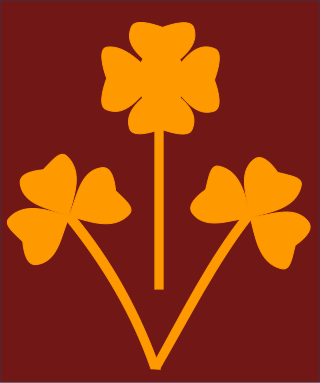
The 4th Indian Infantry Division, also known as the Red Eagle Division, is an infantry division of the Indian Army. This division of the British Indian Army was formed in Egypt in 1939 during the Second World War. During the Second World War, it took part in campaigns in East Africa, Syria, North Africa and Italy. Post independence, the division is part of the I Corps and headquartered at Prayagraj.

The 5th Indian Infantry Division was an infantry division of the Indian Army during World War II that fought in several theatres of war and was nicknamed the "Ball of Fire". It was one of the few Allied divisions to fight against three different armies - the Italian, German and Japanese armies.

The 8th Mountain Division was raised as the 7th Indian Infantry division of the British Indian Army. It is now part of the Indian Army and specialises in mountain warfare.

The 19th Indian Infantry Division was an infantry division of the Indian Army during World War II, and played a prominent part in the final part of the Burma Campaign.

The 17th Infantry Division is a formation of the Indian Army. During the Second World War, it had the distinction of being continually in combat during the three-year-long Burma Campaign. The division was re-raised in 1960 and the 17 Mountain Division is presently located in Sikkim under XXXIII Corps.

The 7th Infantry Division is a war-formed infantry division, part of the British Indian Army that saw service in the Burma Campaign.

The 10th Indian Infantry Division was a war formed infantry division of the Indian Army during World War II. In four years, the division travelled over 4,000 miles (6,400 km) from Tehran to Trieste, fought three small wars, and fought two great campaigns: the Anglo-Iraqi War, the Invasion of Syria–Lebanon, the Anglo-Soviet invasion of Iran, the North African Campaign, and the Italian Campaign.

The 14th Indian Infantry Division was an infantry division of the Indian Army during World War II. It fought in the Arakan Campaign 1942–43, and was subsequently converted into a Training Division, providing drafts of replacements for units of the Fourteenth Army during the Burma Campaign.

The 23rd Indian Infantry Division was an infantry division of the Indian Army during World War II. It fought in the Burma Campaign. It was then reformed as a division of the independent Indian Army in 1959.

The 26th Indian Infantry Division, was an infantry division of the Indian Army during World War II. It fought in the Burma Campaign.
The 11th Indian Infantry Division was an infantry division of the Indian Army during World War II. It formed part of Indian III Corps in the Malaya Command during the Battle of Malaya. The division was re-raised on 1 April 1965 and is presently part of the XII Corps of Southern Command. It is presently responsible for safeguarding the borders with Pakistan along Southern Rajasthan and Gujarat.
The Order of battle of the East African campaign shows the ground forces of both sides in East Africa on the date that the Italians declared war on Britain and France, 10 June 1940 and for the British and Commonwealth forces involved in the 1941 offensive.
The 15th Indian Division was an infantry division of the British Indian Army that saw active service in the First World War. It served in the Mesopotamian Campaign on the Euphrates Front throughout its existence. It did not serve in the Second World War, but was reformed at Dehradun in 1964 as part of the post-independence Indian Army.
This is the order of battle for the ground forces involved in Operation Crusader, a World War II battle between the British Commonwealth and the European Axis Powers of Germany and Italy in North Africa between 18 November – 30 December 1941.
The Burma Corps ('Burcorps') was an Army Corps of the Indian Army during the Second World War. It was formed in Prome, Burma, on 19 March 1942, took part in the retreat through Burma, and was disbanded on arrival in India in May 1942.
The 9th Indian Infantry Brigade was an infantry brigade formation of the Indian Army during World War II. Before the war the 9th (Jhansi) Infantry Brigade was a peacetime formation in Meerut district. This brigade was redesignated the 5th Indian Infantry Brigade and a new 9th Brigade was then formed all in September 1939. The new brigade was assigned to the 5th Indian Infantry Division in June 1940 to January 1944. It then spent February attached to the 7th Indian Infantry Division before returning to the 5th Division. The brigade spent two other short periods away from the 5th Division it was attached to the 17th Indian Infantry Division between March and April 1945 and was with the 19th Indian Infantry Division in April 1945, and returned to the 5th for the rest of the war.
The 161st Indian Infantry Brigade was an infantry brigade formation of the Indian Army during World War II. As part of the arrangements for the independence and partition of British India the brigade was allocated to India and became the 161st Infantry Brigade in the army of the newly independent India.
The 10th Indian Infantry Brigade was an infantry brigade formation of the Indian Army during World War II. It was formed in September 1939. In June 1940 it was assigned to the 5th Indian Infantry Division and in September 1940, sailed for East Africa. The brigade spent time attached to other formations, the 4th Indian Infantry Division between June 1940 and March 1941, and the British 10th Armoured Division between March and June 1942, where it was destroyed during the Battle of Gazala. A new brigade was formed in Egypt and assigned to the 10th Indian Infantry Division, with which it fought in the Italian Campaign from April 1944 until the end of the war.
The 21st Indian Infantry Brigade was an infantry brigade formation of the Indian Army during World War II.

The 54th Infantry Division is an Infantry division of the Indian Army. The Division was raised as an Infantry Division, but was converted into a Reorganised Amphibious Formation (RAMFOR) in 2011. It is currently the only division of the Indian Army which carries out Amphibious warfare. The division is headquartered at Secunderabad in Telangana and is a part of XXI Corps. The Division is commanded by an Officer of the rank of Major General titled General Officer Commanding (GOC).












